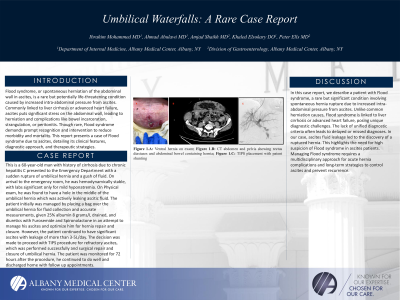Sunday Poster Session
Category: Liver
P1313 - Umbilical Waterfalls: A Rare Case Report
Sunday, October 27, 2024
3:30 PM - 7:00 PM ET
Location: Exhibit Hall E

Has Audio
- IM
Ibrahim Mohammed, MD
Albany Medical Center
Albany, NY
Presenting Author(s)
Ibrahim Mohammed, MD, Ahmad Abulawi, MD, Amjad Shaikh, MD, Khaled Elsokary, DO, Peter Ells, MD
Albany Medical Center, Albany, NY
Introduction: Flood syndrome, or spontaneous herniation of the abdominal wall in ascites, is a rare but potentially life-threatening condition caused by increased intra-abdominal pressure from ascites. Commonly linked to liver cirrhosis or advanced heart failure, ascites puts significant stress on the abdominal wall, leading to herniation and complications like bowel incarceration, strangulation, or peritonitis. Though rare, Flood syndrome demands prompt recognition and intervention to reduce morbidity and mortality. This report presents a case of Flood syndrome due to ascites, detailing its clinical features, diagnostic approach, and therapeutic strategies.
Case Description/Methods: This is a 60-year-old man with history of cirrhosis due to chronic hepatitis C presented to the Emergency Department with a sudden rupture of umbilical hernia and a gush of fluid. On arrival to the emergency room, he was hemodynamically stable, with labs significant only for mild hyponatremia. On Physical exam, he was found to have a hole in the middle of the umbilical hernia which was actively leaking ascitic fluid. The patient initially was managed by placing a bag over the umbilical hernia for fluid collection and accurate measurements, given 25% albumin 8 grams/L drained, and diuretics with Furosemide and Spironolactone in an attempt to manage his ascites and optimize him for hernia repair and closure. However, the patient continued to have significant ascites with leakage of more than 3-5L/day. The decision was made to proceed with TIPS procedure for refractory ascites, which was performed successfully and surgical repair and closure of umbilical hernia. The patient was monitored for 72 hours after the procedure, he continued to do well and discharged home with follow up appointments.
Discussion: In this case report, we describe a patient with Flood syndrome, a rare but significant condition involving spontaneous hernia rupture due to increased intra-abdominal pressure from ascites. Unlike common herniation causes, Flood syndrome is linked to liver cirrhosis or advanced heart failure, posing unique diagnostic challenges. The lack of unified diagnostic criteria often leads to delayed or missed diagnoses. In our case, ascites fluid leakage led to the discovery of a ruptured hernia. This highlights the need for high suspicion of Flood syndrome in ascites patients. Managing Flood syndrome requires a multidisciplinary approach for acute hernia complications and long-term strategies to control ascites and prevent recurrence.

Disclosures:
Ibrahim Mohammed, MD, Ahmad Abulawi, MD, Amjad Shaikh, MD, Khaled Elsokary, DO, Peter Ells, MD. P1313 - Umbilical Waterfalls: A Rare Case Report, ACG 2024 Annual Scientific Meeting Abstracts. Philadelphia, PA: American College of Gastroenterology.
Albany Medical Center, Albany, NY
Introduction: Flood syndrome, or spontaneous herniation of the abdominal wall in ascites, is a rare but potentially life-threatening condition caused by increased intra-abdominal pressure from ascites. Commonly linked to liver cirrhosis or advanced heart failure, ascites puts significant stress on the abdominal wall, leading to herniation and complications like bowel incarceration, strangulation, or peritonitis. Though rare, Flood syndrome demands prompt recognition and intervention to reduce morbidity and mortality. This report presents a case of Flood syndrome due to ascites, detailing its clinical features, diagnostic approach, and therapeutic strategies.
Case Description/Methods: This is a 60-year-old man with history of cirrhosis due to chronic hepatitis C presented to the Emergency Department with a sudden rupture of umbilical hernia and a gush of fluid. On arrival to the emergency room, he was hemodynamically stable, with labs significant only for mild hyponatremia. On Physical exam, he was found to have a hole in the middle of the umbilical hernia which was actively leaking ascitic fluid. The patient initially was managed by placing a bag over the umbilical hernia for fluid collection and accurate measurements, given 25% albumin 8 grams/L drained, and diuretics with Furosemide and Spironolactone in an attempt to manage his ascites and optimize him for hernia repair and closure. However, the patient continued to have significant ascites with leakage of more than 3-5L/day. The decision was made to proceed with TIPS procedure for refractory ascites, which was performed successfully and surgical repair and closure of umbilical hernia. The patient was monitored for 72 hours after the procedure, he continued to do well and discharged home with follow up appointments.
Discussion: In this case report, we describe a patient with Flood syndrome, a rare but significant condition involving spontaneous hernia rupture due to increased intra-abdominal pressure from ascites. Unlike common herniation causes, Flood syndrome is linked to liver cirrhosis or advanced heart failure, posing unique diagnostic challenges. The lack of unified diagnostic criteria often leads to delayed or missed diagnoses. In our case, ascites fluid leakage led to the discovery of a ruptured hernia. This highlights the need for high suspicion of Flood syndrome in ascites patients. Managing Flood syndrome requires a multidisciplinary approach for acute hernia complications and long-term strategies to control ascites and prevent recurrence.

Figure: Figure 1.A: Ventral hernia on exam; Figure 1.B: CT abdomen and pelvis showing rectus diastases and abdominal bowel containing hernia; Figure 1.C: TIPS placement with patent shunting
Disclosures:
Ibrahim Mohammed indicated no relevant financial relationships.
Ahmad Abulawi indicated no relevant financial relationships.
Amjad Shaikh indicated no relevant financial relationships.
Khaled Elsokary indicated no relevant financial relationships.
Peter Ells indicated no relevant financial relationships.
Ibrahim Mohammed, MD, Ahmad Abulawi, MD, Amjad Shaikh, MD, Khaled Elsokary, DO, Peter Ells, MD. P1313 - Umbilical Waterfalls: A Rare Case Report, ACG 2024 Annual Scientific Meeting Abstracts. Philadelphia, PA: American College of Gastroenterology.
